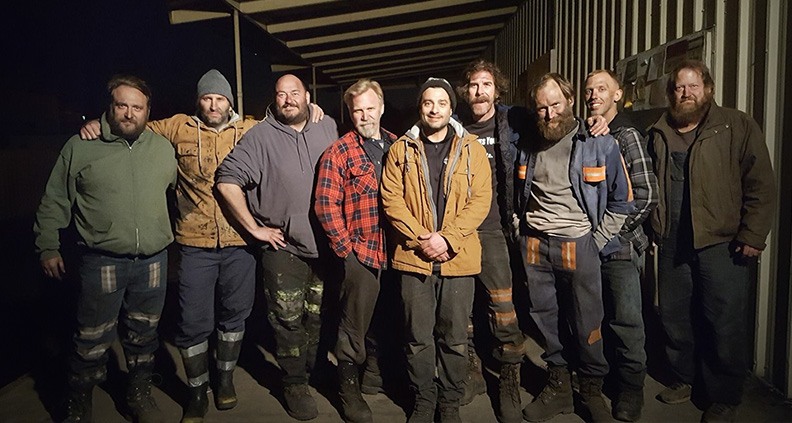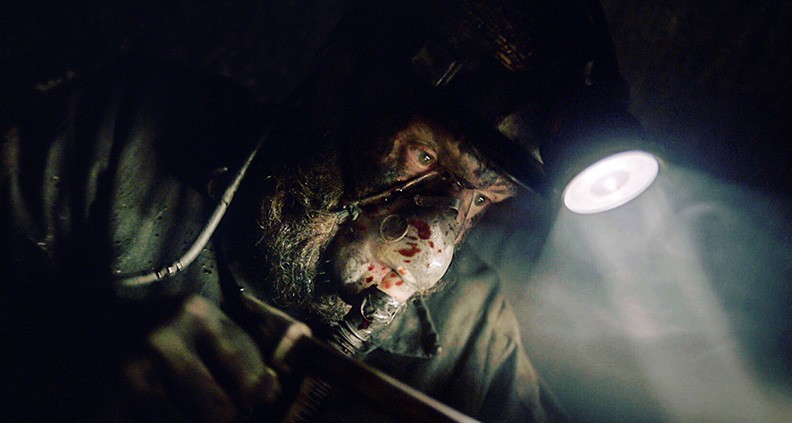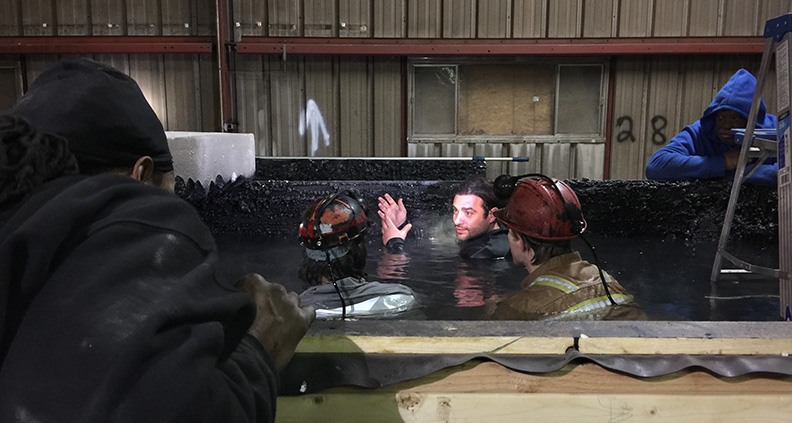Survival Thriller ‘Mine 9’ Gives the Term ‘Underground Film’ New Meaning
In brainstorming visually compelling locations for a tense, confined-space thriller, it’d be hard to do much better than the murky, subterranean depths of a West Virginia coalmine. With sooty corridors maxing out at a mere four vertical feet and chockablock full of noisy industrial machinery, these mines are hostile places to be even in the best of circumstances. Never mind the fact that, historically, these mines have so often collapsed, trapping workers deep underground with little oxygen and dependent on emergency rescue services.
Such a rescue operation forms the basis of filmmaker—and 2015 Film Independent Directing Lab Fellow—Eddie Mensore’s new thriller Mine 9, which chronicles with procedural detail events following a (fictional) mining collapse deep in the heart of West Virginia coal country. Told primarily from the perspective of the men trapped underground, it’s a tense, authentic survival tale, and is already a huge local hit in Appalachia.
We recently spoke to Mensore about the film—which opens in theaters this Friday, June 7 in Los Angeles and June 28 in New York—as well as his experience in Film Independent’s Directing Lab, his approach to sound design and much more. Here’s the conversation:
EDDIE MENSORE

To start, can you tell me about your own relationship to this story and the world of coal mining?
Mensore: I’m originally from West Virginia, so I was around coal mining my entire life. During my youth there were a handful of coal mining accidents that really shook our state—things that were on the news, where time stops for a moment and everyone just holds their breath until there’s some sort of resolution. So that was the initial backstory. But then as a filmmaker, you’re always trying to find something no one has made. Being trapped two miles under the earth with an hour of oxygen, and the room from the floor to the ceiling is four feet tall; it made for quite a claustrophobic thriller.
How much research did you do in order to feel like you were able to speak to these experiences authentically?
Mensore: It was ridiculous! It was like learning a second language [laughs]. These guys are engineers, they’re mechanics, they’re rescue professionals. You know, it’s like a doctor watching a medical drama. There’s only so much we could get right. But it was really like learning a new language, just to have some authenticity to it.
I was going to ask if you’d gotten any feedback from actual coal miners. I’m sure they may have small things to say about the way things presented technically, but I’m more interested in what the emotional response has been.
Mensore: It’s been quite unbelievable. We had two premieres, and opened on 24 screens throughout Appalachia. So we got picked up rather quickly in that region, just due to the subject matter. A lot of distribution entities we’d talked to, they said you better release this movie anywhere but the coal-mining region. To me that was backwards thinking, because these people put their lives on the line every day, so a movie isn’t going to scare them at all.

How did you approach using sound to tell your story?
Mensore: Sound for this was just a labor of love, really. If you were trapped two miles under the earth, what would it sound like? So [we went for] lots of trippy, industrial sounds. I really wanted some of that Appalachian folk ballad music to shine through. There was gentleman by the name of Nimrod Workman, who I believe recorded his first CD at 80 years old. He started working in coalmines at nine, and he sang to himself to keep himself from being scared. So I always had that haunting music in the back of my head. I had to find a 25-year-old kid who could sing ballad music, and we went in and wrote a lot of that music together. It was really just trying to put you in that place, that Appalachian world.
What about the actual shoot?
Mensore: It took me seven years to find a coalmine where I was allowed to film. But we found a mine and we went down there and filmed for a day-and-a-half with a skeleton crew. We filmed real coal miners operating their real equipment. We brought our actors with us just so they could go underground. Any time you see someone operate the equipment from the back or from the side, it’s a real coal miner. Whenever you see it from the front, it’s our actors with VFX. Everything before [the inciting incident] is from the real coalmine. Everything after that—not everything, but the majority of stuff—is on a set, in Atlanta. You’re hunched over crawling all day; it’s Mad Max in a Being John Malkovich environment.
When you go down in a mine like that for the first time, what details did you notice that you wanted to try and re-create cinematically?
Mensore: It’s all summed up by the young boy, Ryan (Drew Starkey)—it’s his first day in the mine. And to me, that’s the audience. Ryan’s fear, his claustrophobia, I tried talking all of those elements I had in my own head and putting them into his character, trying to get the audience to see through his eyes.

You’re a 2015 Film Independent Directing Lab Fellow. What did you get out of that experience?
Mensore: I got a great deal out of the Lab. I was in two different production deals with this project—it was a much bigger project, with a bigger budget and some name talent attached. And for one reason or another, it kept backfiring. I really lost my confidence. Then Film Independent accepted me into the Directing Lab. It was really great getting into a room and hearing other filmmakers’ feedback. Getting to workshop everything and think through how, technically, you would go about making it all, it gave me the confidence to—weirdly enough—leave Los Angeles and move to Atlanta to just go and make my movie.
What are you working on next?
Mensore: I have a project called A Violent Time. It’s about the unionization of coal miners in 1920s West Virginia, based on one of the biggest labor uprisings of all time, called The Battle of Blair Mountain. I’ve found a good niche with releasing movies theatrically in Appalachia—we’ve played in over 50 theaters [with MINE 9] at this point, and have actually been generating some revenue. So that’s allowed me to hopefully go back and do it all over again.
To see when and where Mine 9 is playing near you, click here. To learn more about Film Independent’s myriad Artist Develop programs, including the Directing Lab, just click here. And whatever you do, stay above ground!